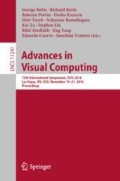Abstract
Skull stripping is an important preprocessing step on cerebral Magnetic Resonance (MR) images because unnecessary brain structures, like eye balls and muscles, greatly hinder the accuracy of further automatic diagnosis. To extract important brain tissue quickly, we developed a model named Confidence Segmentation Convolutional Neural Network (CSCNet). CSCNet takes the form of a Fully Convolutional Network (FCN) that adopts an encoder-decoder architecture which gives a reconstructed bitmask with pixel-wise confidence level. During our experiments, a crossvalidation was performed on 750 MRI slices of the brain and demonstrated the high accuracy of the model (dice score: \(0.97\pm 0.005\)) with a prediction time of less than 0.5 s.
K. Chen and J. Shen—Equal Contribution.
Access this chapter
Tax calculation will be finalised at checkout
Purchases are for personal use only
References
Badrinarayanan, V., Kendall, A., Cipolla, R.: SegNet: a deep convolutional encoder-decoder architecture for image segmentation (2015). arXiv:1511.00561
Ronneberger, O., Fischer, P., Brox, T.: U-Net: convolutional networks for biomedical image segmentation. In: Navab, N., Hornegger, J., Wells, W.M., Frangi, A.F. (eds.) MICCAI 2015. LNCS, vol. 9351, pp. 234–241. Springer, Cham (2015). https://doi.org/10.1007/978-3-319-24574-4_28
Kalavathi, P., Surya Prasath, V.B.: Methods on Skull Stripping of MRI Head Scan Images - a Review. Advances in Pediatries. U.S. National Library of Medicine (2016). www.ncbi.nlm.nih.gov/pmc/articles/PMC4879034
Raunak, D., Yi, H.: CompNet: complementary segmentation network for brain MRI extraction (2018). arXiv preprint arXiv:1804.00521v2
Paszke, A., Chaurasia, A., Kim, S., Culurciello, E.: ENet: a deep neural network architecture for real-time semantic segmentation (2016). arXiv:1606.02147v1
Yunjie, C., Jianwei, Z., Shunfeng, W.: A new fast brain skull stripping method, biomedical engineering and informatics. In: Tianjin: Proceedings 2nd International Conference on Biomedical Engineering and Informatics, BMEI 2009 (2009)
Kleesiek, J., et al.: Deep MRI brain extraction: a 3D convolutional neural network for skull stripping. NeuroImage, 129, 460–469 (2016)
Long, J., Shelhamer, E., Darrell, T.: Fully convolutional networks for semantic segmentation. In: Proceedings of the IEEE Conference on Computer Vision and Pattern Recognition, pp. 3431–3440 (2015)
Hengshuang Z., Jianping S., Xiaojuan Q., Xiaogang W., Jiaya J. Pyramid scene parsing network. CoRR, abs/1612.01105 (2016)
Butman, J., Roy, S., Pham, D.: Robust skull stripping using multiple MR image contrasts insensitive to pathology. NeuroImage 146, 132–147 (2017)
Akkus, Z., Kostandy, P.M., Philbrick, K.A., Erickson, B.J.: Extraction of brain tissue from CT head images using fully convolutional neural networks. In: Proceedings of SPIE, Medical Imaging 2018: Image Processing, vol. 10574, p. 1057420, 2 March 2018. https://doi.org/10.1117/12.2293423
Krizhevsky, A., Sutskever, I., Hinton, G.E.: ImageNet classification with deep convolutional neural networks. In: Pereira, F., Burges, C.J.C., Bottou, L., Weinberger, K.Q. (eds.) Advances in Neural Information Processing Systems, vol. 25, pp. 1097–1105. Curran Associates Inc. (2012)
Simonyan, K., Zisserman, A.: Very deep convolutional networks for large-scale image recognition. CoRR, abs/1409.1556 (2014)
Szegedy, C., et al.: Going deeper with convolutions. CoRR, abs/1409.4842 (2014)
Gu, J., et al.: Recent advances in convolutional neural networks. CoRR, abs/1512.07108 (2015)
He, K., Zhang, X., Ren, S., Sun, J.: Deep Residual Learning for Image Recognition. CoRR, abs/1512.03385 (2015)
Kendall, A., Badrinarayanan, V., Cipolla, R.: Bayesian SegNet: model uncertainty in deep convolutional encoder-decoder architectures for scene understanding. CoRR, abs/1511.02680 (2015)
Srivastava, N., Hinton, G., Krizhevsky, A., Sutskever, I., Salakhutdinov, R.: Dropout: a simple way to prevent neural net- works from overfitting. J. Mach. Learn. Res. 15(1), 1929–1958 (2014)
Zeiler, M.D., Fergus, R.: Visualizing and Understanding Convolutional Networks. CoRR, abs/1311.2901 (2013)
Author information
Authors and Affiliations
Corresponding author
Editor information
Editors and Affiliations
Rights and permissions
Copyright information
© 2018 Springer Nature Switzerland AG
About this paper
Cite this paper
Chen, K., Shen, J., Scalzo, F. (2018). Skull Stripping Using Confidence Segmentation Convolution Neural Network. In: Bebis, G., et al. Advances in Visual Computing. ISVC 2018. Lecture Notes in Computer Science(), vol 11241. Springer, Cham. https://doi.org/10.1007/978-3-030-03801-4_2
Download citation
DOI: https://doi.org/10.1007/978-3-030-03801-4_2
Published:
Publisher Name: Springer, Cham
Print ISBN: 978-3-030-03800-7
Online ISBN: 978-3-030-03801-4
eBook Packages: Computer ScienceComputer Science (R0)

